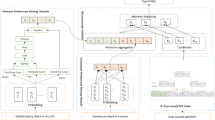Abstract
Point-of-Interest (POI) recommender systems can effectively assist users to find their preferred POIs. Recent studies mainly focus on extracting users’ dynamic context from their check-in behaviors and using attention mechanism to capture different influence of context information for predicting their real-time requirements. However, the existing methods mainly focus on learning the weights of different POI as well as their correlations in the check-in sequences. In addition, these methods still suffer from limited performance, especially when the interaction data are sparse. In this paper, we propose a C ontext- and C ategory-aware D ouble S elf-A ttention (CCDSA) model for POI recommendation to explore and capture users’ contextual preferences in two different aspects collaboratively, including the fine-grained preference for POI in check-in behaviors and the coarse-grained preference for category. Specifically, we first design a double self-attention mechanism module to learn the users’ preferences for both POI and category in specific context. Then we combine users’ check-in behaviors with POIs’ category information to alleviate data sparsity problem in context-aware recommendation. Finally, we leverage context and category information to perform personalized POI recommendation. In particular, we devise an improved version of CCDSA, i.e., CCDSA+, which further replaces the self-attention mechanism with the sparse self-attention mechanism for improving training efficiency. The experimental results on four real-world datasets, Foursquare-NY, Foursquare-TKY, Weeplaces-NY and Weeplaces-SF show that the proposed models, CCDSA and CCDSA+, outperform the baselines.
















Similar content being viewed by others
References
Gao H, Tang J, Hu X, Liu H (2015) Content-aware point of interest recommendation on location-based social networks. In: Twenty-ninth AAAI conference on artificial intelligence, pp 1721–1727
Shi H, Chen L, Xu Z, Lyu D (2019) Personalized location recommendation using mobile phone usage information. Appl Intell 49(10):3694–3707
Wu Y, Li K, Zhao G, Qian X (2019) Long-and short-term preference learning for next poi recommendation. In: Proceedings of the 28th ACM International conference on information and knowledge management, pp 2301–2304
Cho E, Myers SA, Leskovec J (2011) Friendship and mobility: user movement in location-based social networks. In: Proceedings of the 17th ACM SIGKDD International conference on knowledge discovery and data mining, pp. 1082–1090
Zhou H, Zhang S, Peng J, Zhang S, Li J, Xiong H, Zhang W (2021) Informer: beyond efficient transformer for long sequence time-series forecasting. In: Proceedings of AAAI, pp 11106– 11115
Liu W, Lai H, Wang J, Ke G, Yang W, Yin J (2020) Mix geographical information into local collaborative ranking for poi recommendation. World Wide Web 23(1):131–152
Yuan T, Cheng J, Zhang X, Qiu S, Lu H (2014) Recommendation by mining multiple user behaviors with group sparsity. In: Twenty-eighth AAAI conference on artificial intelligence
Ramaswamy L, Deepak P, Polavarapu R, Gunasekera K, Garg D, Visweswariah K, Kalyanaraman S (2009) Caesar: A context-aware, social recommender system for low-end mobile devices. In: 2009 10th International conference on mobile data management: Systems, Services and Middleware, pp 338–347. IEEE
Chen Y, Zhao J, Hu X, Zhang X, Li Z, Chua T-S (2013) From interest to function: location estimation in social media. In: Twenty-seventh AAAI conference on artificial intelligence
Bao J, Zheng Y, Wilkie D, Mokbel M (2015) Recommendations in location-based social networks: a survey. GeoInformatica 19(3):525–565
Yu D, Wanyan W, Wang D (2021) Leveraging contextual influence and user preferences for point-of-interest recommendation. Multimed Tools Appl 80(1):1487–1501
Lyu D, Chen L, Xu Z, Yu S (2020) Weighted multi-information constrained matrix factorization for personalized travel location recommendation based on geo-tagged photos. Appl Intell 50(3):924–938
Wang H, Li G, Feng J (2014) Group-based personalized location recommendation on social networks. In: Asia-Pacific Web conference, pp 68–80. Springer
Wang D, Xu D, Yu D, Xu G (2021) Time-aware sequence model for next-item recommendation. Appl Intell 51(2):906–920
Wen P, Yuan W, Qin Q, Sang S, Zhang Z (2021) Neural attention model for recommendation based on factorization machines. Appl Intell 51(4):1829–1844
Sun K, Qian T, Chen T, Liang Y, Nguyen QVH, Yin H (2020) Where to go next: modeling long-and short-term user preferences for point-of-interest recommendation. In: The thirty-fourth AAAI conference on artificial intelligence, AAAI 2020, the thirty-second innovative applications of artificial intelligence conference, IAAI 2020, the tenth AAAI symposium on educational advances in artificial intelligence, EAAI 2020, new york, NY, USA, February 7-12, 2020, pp 214–221
Zhan G, Xu J, Huang Z, Zhang Q, Xu M, Zheng N (2019) A semantic sequential correlation based lstm model for next poi recommendation. In: 2019 20th IEEE International Conference on Mobile Data Management (MDM), pp. 128–137. IEEE
Manotumruksa J, Macdonald C, Ounis I (2017) A deep recurrent collaborative filtering framework for venue recommendation. In: Proceedings of the 2017 ACM on conference on information and knowledge management, pp 1429–1438
Liu Q, Wu S, Wang L, Tan T (2016) Predicting the next location: a recurrent model with spatial and temporal contexts. In: Proceedings of the 38th AAAI Conference on artificial intelligence, February 12-17, 2016, Phoenix, Arizona, USA, pp 194–200
Yang D, Fankhauser B, Rosso P, Cudre-Mauroux P (2020) Location prediction over sparse user mobility traces using rnns: Flashback in hidden states!. In: Proceedings of the 29th International joint conference on artificial intelligence, pp 2184–2190
Chen Y-C, Thaipisutikul T, Shih TK (2020) A learning-based poi recommendation with spatiotemporal context awareness. IEEE Transactions on Cybernetics
Yu F, Cui L, Guo W, Lu X, Li Q, Lu H (2020) A category-aware deep model for successive poi recommendation on sparse check-in data. In: Proceedings of the Web conference 2020, pp 1264– 1274
Wang D, Wang X, Xiang Z, Yu D, Deng S, Xu G (2021) Attentive sequential model based on graph neural network for next poi recommendation. World Wide Web 24(6):2161–2184
Chang L, Chen W, Huang J, Bin C, Wang W (2021) Exploiting multi-attention network with contextual influence for point-of-interest recommendation. Appl Intell 51(4):1904–1917
Chen J, Zhang H, He X, Nie L, Liu W, Chua T-S (2017) Attentive collaborative filtering: Multimedia recommendation with item-and component-level attention. In: Proceedings of the 40th International ACM SIGIR Conference on research and development in information retrieval, pp 335–344
Xiao J, Ye H, He X, Zhang H, Wu F, Chua T-S (2017) Attentional factorization machines: Learning the weight of feature interactions via attention networks. In: Proceedings of the 26th International joint conference on artificial intelligence, pp 3119–3125
Wang S, Hu L, Cao L, Huang X, Lian D, Liu W (2018) Attention-based transactional context embedding for next-item recommendation. In: Proceedings of the AAAI conference on artificial intelligence, vol 32
Vaswani A, Shazeer N, Parmar N, Uszkoreit J, Jones L, Gomez AN, Kaiser Ł., Polosukhin I (2017) Attention is all you need. In: Advances in neural information processing systems, pp 5998–6008
Kang W-C, McAuley J (2018) Self-attentive sequential recommendation. In: 2018 IEEE International Conference on Data Mining (ICDM), pp 197–206. IEEE
Zhang S, Tay Y, Yao L, Sun A, An J (2019) Next item recommendation with self-attentive metric learning. In: 33rd AAAI conference on artificial intelligence, vol 9
Sun F, Liu J, Wu J, Pei C, Lin X, Ou W, Jiang P (2019) Bert4rec: sequential recommendation with bidirectional encoder representations from transformer. In: Proceedings of the 28th ACM International conference on information and knowledge management, pp 1441–1450
Li Z, Cheng W, Xiao H, Yu W, Chen H, Wang W (2021) You are what and where you are: graph enhanced attention network for explainable poi recommendation. In: Proceedings of the 30th ACM International conference on information & knowledge management, pp 3945–3954
Rendle S, Freudenthaler C, Schmidt-Thieme L (2010) Factorizing personalized markov chains for next-basket recommendation. In: Proceedings of the 19th International conference on World Wide Web, pp 811–820
He R, Kang W-C, McAuley J (2017) Translation-based recommendation. In: Proceedings of the 11th ACM Conference on recommender systems, pp 161–169
He R, McAuley J (2016) Fusing similarity models with markov chains for sparse sequential recommendation. In: 2016 IEEE 16th International Conference on Data Mining (ICDM), pp 191–200. IEEE
Tsai Y-HH, Bai S, Yamada M, Morency L-P, Salakhutdinov R (2019) Transformer dissection:, An unified understanding for transformer’s attention via the lens of kernel, pp 4344–4353
Kingma DP, Ba J (2015) Adam: a method for stochastic optimization. In: 3Rd international conference on learning representations, ICLR 2015, san diego, CA, USA, May 7-9, 2015, Conference track proceedings
Liu Y, Pham T-AN, Cong G, Yuan Q (2017) An experimental evaluation of point-of-interest recommendation in location-based social networks. Proc VLDB Endow 10(10):1010–1021
He X, Liao L, Zhang H, Nie L, Hu X, Chua T-S (2017) Neural collaborative filtering. In: Proceedings of the 26th International conference on World Wide Web, pp 173–182
Tang J, Wang K (2018) Personalized top-n sequential recommendation via convolutional sequence embedding. In: Proceedings of the 11th ACM International conference on Web search and data mining, pp 565–573
Li X, Jiang M, Hong H, Liao L (2017) A time-aware personalized point-of-interest recommendation via high-order tensor factorization. ACM Trans Inf Syst(TOIS) 35(4):1–23
Rahmani HA, Aliannejadi M, Baratchi M, Crestani F (2020) Joint geographical and temporal modeling based on matrix factorization for point-of-interest recommendation. In: European conference on information retrieval, pp 205–219. Springer
Ma C, Zhang Y, Wang Q, Liu X (2018) Point-of-interest recommendation: exploiting self-attentive autoencoders with neighbor-aware influence. In: Proceedings of the 27th ACM International conference on information and knowledge management, pp 697–706
Krichene W, Rendle S (2022) On sampled metrics for item recommendation. Commun ACM 65(7):75–83
Tanjim MM, Su C, Benjamin E, Hu D, Hong L, McAuley J (2020) Attentive sequential models of latent intent for next item recommendation. In: Proceedings of the Web conference 2020, pp 2528–2534
Wang D, Zhang X, Yu D, Xu G, Deng S (2020) Came: content-and context-aware music embedding for recommendation. IEEE Trans Neural Netw Learn Syst 32(3):1375–1388
Wu J, Zhao Z, Sun Q, Fujita H (2021) A maximum self-esteem degree based feedback mechanism for group consensus reaching with the distributed linguistic trust propagation in social network. Inf Fusion 67:80–93
Wu J, Wang S, Chiclana F, Herrera-Viedma E (2021) Two-fold personalized feedback mechanism for social network consensus by uninorm interval trust propagation. IEEE Transactions on Cybernetics
Funding
This research was supported by the National Natural Science Foundation of China under Grant No.62202131, Zhejiang Provincial Natural Science Foundation of China under No.LQ20F020015, and Zhejiang Provincial Key Science and Technology Program Foundation under No.2020C01165.
Author information
Authors and Affiliations
Corresponding author
Ethics declarations
Competing of Interests
All authors declare that they have no conflict of interest.
Additional information
Publisher’s note
Springer Nature remains neutral with regard to jurisdictional claims in published maps and institutional affiliations.
Rights and permissions
Springer Nature or its licensor (e.g. a society or other partner) holds exclusive rights to this article under a publishing agreement with the author(s) or other rightsholder(s); author self-archiving of the accepted manuscript version of this article is solely governed by the terms of such publishing agreement and applicable law.
About this article
Cite this article
Wang, D., Wan, F., Yu, D. et al. Context-and category-aware double self-attention model for next POI recommendation. Appl Intell 53, 18355–18380 (2023). https://doi.org/10.1007/s10489-022-04396-1
Accepted:
Published:
Issue Date:
DOI: https://doi.org/10.1007/s10489-022-04396-1




